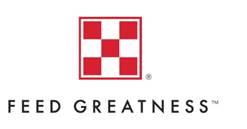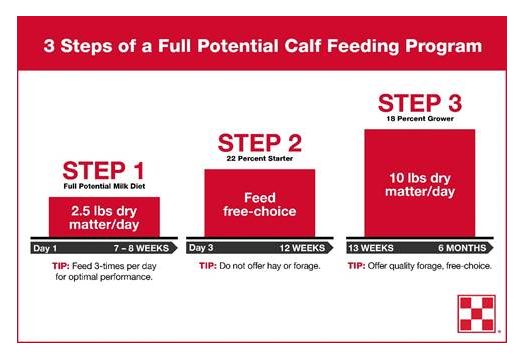The information listed below has been supplied by dairy marketers and other industry organizations. The information provided here has not been edited, verified or endorsed by Hoard’s Dairyman.


Are you leaving performance on the table? If you aren’t feeding your calves a full potential diet, you might be doing just that. A recent USDA study found that of the 49.9 percent of operations feeding milk replacer, an alarming 89.7 percent feed a milk replacer with less than 25 percent protein – the minimum criteria for a full potential diet.[1]
“These findings are consistent with market research conducted by Purina Animal Nutrition in 2015 which found only one-third of calf raisers are capitalizing on feeding a full potential milk diet[2],” explains Kevin Dill, Ph.D., dairy nutritionist with Purina Animal Nutrition. “Calf raisers have the opportunity to take simple steps to positively impact the future of their herd.”
More than a decade of university research confirms feeding calves a full potential diet will drive optimal feed efficiency, healthier calves and potential for greater milk production. In fact, an 8-year study showed that feeding a higher plane of nutrition will result in an increase in first lactation milk production performance as much as 2,740 pounds.[3]
So, how does your calf feeding program measure-up? How can you improve and capture more milk production? Ensuring you feed your calves a full potential program is as easy as 1-2-3.

- Step 1 - Full potential milk diet: A program designed for optimal growth includes a full potential milk replacer fed from day one through seven to eight weeks of age at 2.5 pounds of dry matter per day. Consider switching to a cold weather seasonal calf milk replacer to provide added energy during periods of cold stress and a warm weather formula when temperatures moderate. This approach to feeding is designed to be more cost-efficient in meeting the calf’s needs by delivering the right nutrients at the right times.
- Step 2 - 22 percent starter: Along with feeding a high-quality milk replacer, it is essential to feed a high-protein calf starter containing 22 percent protein. Starter makes up 75 percent of your calf’s energy and protein in the first 12 weeks of life, which is critical for proper structural growth and weight gain.At 3 days of age, offer small amounts of starter grain to stimulate early intake, digestion and gut development. Increase the amount of starter offered to calves as consumption grows to provide a free-choice diet.
- Step 3 - 18 percent grower: The third and final step is vital because even at 13 weeks of age, a calf’s rumen is not fully developed. Transitioning to an 18 percent grower diet after starter grain will help support rumen development – a critical element for lifetime productivity.
“It’s important that we provide calves a high plane of nutrition that can optimize health, feed efficiency, lower age at first calving and support future milk production,” says Dill.“Calf raisers should evaluate their feeding program to make sure they’re giving their calves every opportunity to realize their full potential to be a productive cow.”
Without proper nutrition, calves are left vulnerable to health and growth challenges that can have a negative impact. The Purina® AMPLI-CALF® Program is a simple, full potential feeding program. Each product and feeding rate has been thoroughly researched and can result in an increase in first lactation milk production performance as much as 2,740 pounds.[4]
For more information, contact Kevin Dill at kjdill@landolakes.com or visit: www.amplicalf.com.
For additional information on dairy nutrition and management, sign-up to receive the monthly Purina®HERDSMART® E-mail; a free online tool to improve operational efficiency by visiting: purinaherdsmart.com.
Purina Animal Nutrition LLC (www.purinamills.com) is a national organization serving producers, animal owners and their families through more than 4,700 local cooperatives, independent dealers and other large retailers throughout the United States. Driven to unlock the greatest potential in every animal, the company is an industry-leading innovator offering a valued portfolio of complete feeds, supplements, premixes, ingredients and specialty technologies for the livestock and lifestyle animal markets. Purina Animal Nutrition LLC is headquartered in Shoreview, Minn. and a wholly owned subsidiary of Land O’Lakes, Inc.
Because of factors outside of Purina Animal Nutrition LLC’s control, individual results to be obtained, including but not limited to: financial performance, animal condition, health or performance cannot be predicted or guaranteed by Purina Animal Nutrition LLC.
10.07.2016









